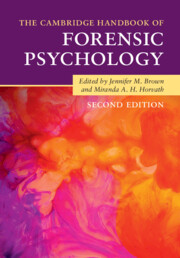Book contents
- The Cambridge Handbook of Forensic Psychology
- The Cambridge Handbook of Forensic Psychology
- Copyright page
- Dedication
- Contents
- Figures
- Tables
- Contributors
- Preface
- Forensic Psychology
- Part I Psychological Underpinnings
- Part II Psychology and Criminal Behaviour
- Part III Assessment
- 3.1 Credibility and Investigative Interviewing
- 3.2 Eyewitness Testimony
- 3.3 Psychopathic Personality Disorder
- 3.4 Forensic Mental Health Assessments
- 3.5 Intellectual Disabilities and Offending Behaviour
- 3.6 Head Injury and Offending
- 3.7 Parole Decision-Making
- 3.8 Risk and Dangerousness in Adults
- Part IV Interventions
- Part V Civil Proceedings
- Part VI Professional Practices
- Index
- References
3.2 - Eyewitness Testimony
from Part III - Assessment
Published online by Cambridge University Press: 02 December 2021
- The Cambridge Handbook of Forensic Psychology
- The Cambridge Handbook of Forensic Psychology
- Copyright page
- Dedication
- Contents
- Figures
- Tables
- Contributors
- Preface
- Forensic Psychology
- Part I Psychological Underpinnings
- Part II Psychology and Criminal Behaviour
- Part III Assessment
- 3.1 Credibility and Investigative Interviewing
- 3.2 Eyewitness Testimony
- 3.3 Psychopathic Personality Disorder
- 3.4 Forensic Mental Health Assessments
- 3.5 Intellectual Disabilities and Offending Behaviour
- 3.6 Head Injury and Offending
- 3.7 Parole Decision-Making
- 3.8 Risk and Dangerousness in Adults
- Part IV Interventions
- Part V Civil Proceedings
- Part VI Professional Practices
- Index
- References
Summary
Eyewitnesses play a significant role in criminal investigations and legal processes worldwide. Just like any other type of forensic evidence, eyewitness evidence has a margin of error. These errors, caused by numerous factors, affect the validity of eyewitness testimony. Some factors emerge at the moment of witnessing, while others occur afterwards. One of the main challenges for legal practitioners is to base their interviewing practices and decision-making on solid scientific evidence. Insight into the cognitive processes of a witness is vital for understanding why people make mistakes. Therefore, our chapter starts with a brief explanation of the organization of memory. Then, using a realistic example, we describe several variables that affect witness testimony, while loosely following the three stages of memory: witnessing, retention and retrieval. Next, we discuss various factors affecting judges’ and jurors’ assessments of witness testimony, which in turn influence legal decision-making. Finally, we summarize our findings and make some concluding remarks.
Keywords
- Type
- Chapter
- Information
- The Cambridge Handbook of Forensic Psychology , pp. 353 - 368Publisher: Cambridge University PressPrint publication year: 2021
References
- 1
- Cited by



